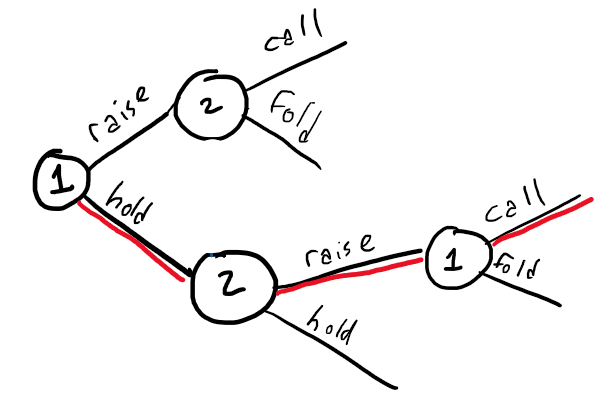what game are we playing: Difference between revisions
| Line 35: | Line 35: | ||
where <math> e = f = (1, 0, ..., 0)^T </math> and <math> E, F</math> contain entries in <math> {-1, 0, 1} </math> describing compatibility and information sets. | where <math> e = f = (1, 0, ..., 0)^T </math> and <math> E, F</math> contain entries in <math> {-1, 0, 1} </math> describing compatibility and information sets. | ||
The paper's main contribution is to develop a minmax problem for extensive form games | The paper's main contribution is to develop a minmax problem for extensive form games: | ||
Revision as of 22:19, 11 November 2020
Authors
Yuxin Wang, Evan Peters, Yifan Mou, Sangeeth Kalaichanthiran
Introduction
Quantal response in Normal form games
Learning Extensive form games
The normal form representation for games where players have _many_ choices quickly becomes intractable. For example, consider a chess game: One the first turn, player 1 has 20 possible moves and then player 2 has 20 possible responses. If in the following number of turns each player is estimated to have ~30 possible moves and if a typical game is 40 moves per player, the total number of strategies is roughly [math]\displaystyle{ 10^{120} }[/math] per player (this is known as the Shannon number for game-tree complexity of chess) and so the payoff matrix for a typical game of chess must therefore have [math]\displaystyle{ O(10^{240}) }[/math] entries.
Instead, it is much more useful to represent the game graphically (in "Extensive form"). We'll also need to consider types of games where there is incomplete information - players do not necessarily have access to the full state of the game. An example of this is one-card poker: (1) Each player draws a single card from a 13-card deck (ignore suits) (2) Player 1 decides whether to bet/hold (3) Player 2 decides whether to call/raise (4) Player 1 must either call/fold if Player 2 raised. From this description, player 1 has [math]\displaystyle{ 2^{13} }[/math] possible first moves (all combinations of (card, raise/hold)) and has [math]\displaystyle{ 2^{13} }[/math] possible second moves (whenever player 1 gets a second move) for a total of [math]\displaystyle{ 2^{26} }[/math] possible strategies. In addition, Player 1 never knows what cards player 2 has and vice versa. So instead of representing the game with a huge payoff matrix we can instead represent it as a simple decision tree (for a single drawn card of player 1):

where player 1 is represented by "1", a node that has two branches corresponding to the allowed moves of player 1. However there must also be a notion of information available to either player: While this tree might correspond to say, player 1 holding a "9", it contains no information on what card player 2 is holding. This leads to the definition of an information set: the set of all nodes belonging to a single player for which the other player cannot distinguish which node has been reached. In the poker example, the full game tree consists of 13 repetitions of the tree shown above and an example of an information set for player 1 is the set of all of nodes owned by player 2 that immediately follow player 1's decision to hold. In other words, if player 1 holds there are 13 possible nodes describing the responses of player 2 (raise/hold for player 2 having card = ace, 1, ... King) and all 13 of these nodes are indistinguishable to player 1.
Let [math]\displaystyle{ U_i }[/math] be the set of all information sets for player i, and for each [math]\displaystyle{ t \in T_i }[/math] let [math]\displaystyle{ \sigma_t }[/math] be the actions taken by player i to arrive at [math]\displaystyle{ t }[/math] and [math]\displaystyle{ C_t }[/math] be the actions that player i can take from [math]\displaystyle{ u }[/math]. Then the set of all possible sequences that can be taken by player i is given by
$$ S_i = \{\emptyset \} \cup \{ \sigma_t c | u\in T_i, c \in C_t \} $$
So for the one-card poker we would have [math]\displaystyle{ S_1 = \{\emptyset, \text{raise}, \text{hold}, \text{hold-call}, \text{hold-fold\} } }[/math]. From the possible sequences follows two important concepts:
1. The payoff matrix is size [math]\displaystyle{ |S_1| \times |S_2| }[/math], since this is all possible actions available to either player 2. A realization plan [math]\displaystyle{ u \in \mathbb{R}^{|S_1|} }[/math] for player 1 ([math]\displaystyle{ v \mathbb{R}^{|S_2|} }[/math] for player 2 ) will describe probabilities for players to carry out each possible sequence, and each realization plan must be constrained by (i) compatibility of sequences (e.g. "raise" is not compatible with "hold-call") and (ii) information sets available to the player. These constraints are linear:
$$ Eu = e \\ Fv = f $$
where [math]\displaystyle{ e = f = (1, 0, ..., 0)^T }[/math] and [math]\displaystyle{ E, F }[/math] contain entries in [math]\displaystyle{ {-1, 0, 1} }[/math] describing compatibility and information sets.
The paper's main contribution is to develop a minmax problem for extensive form games: